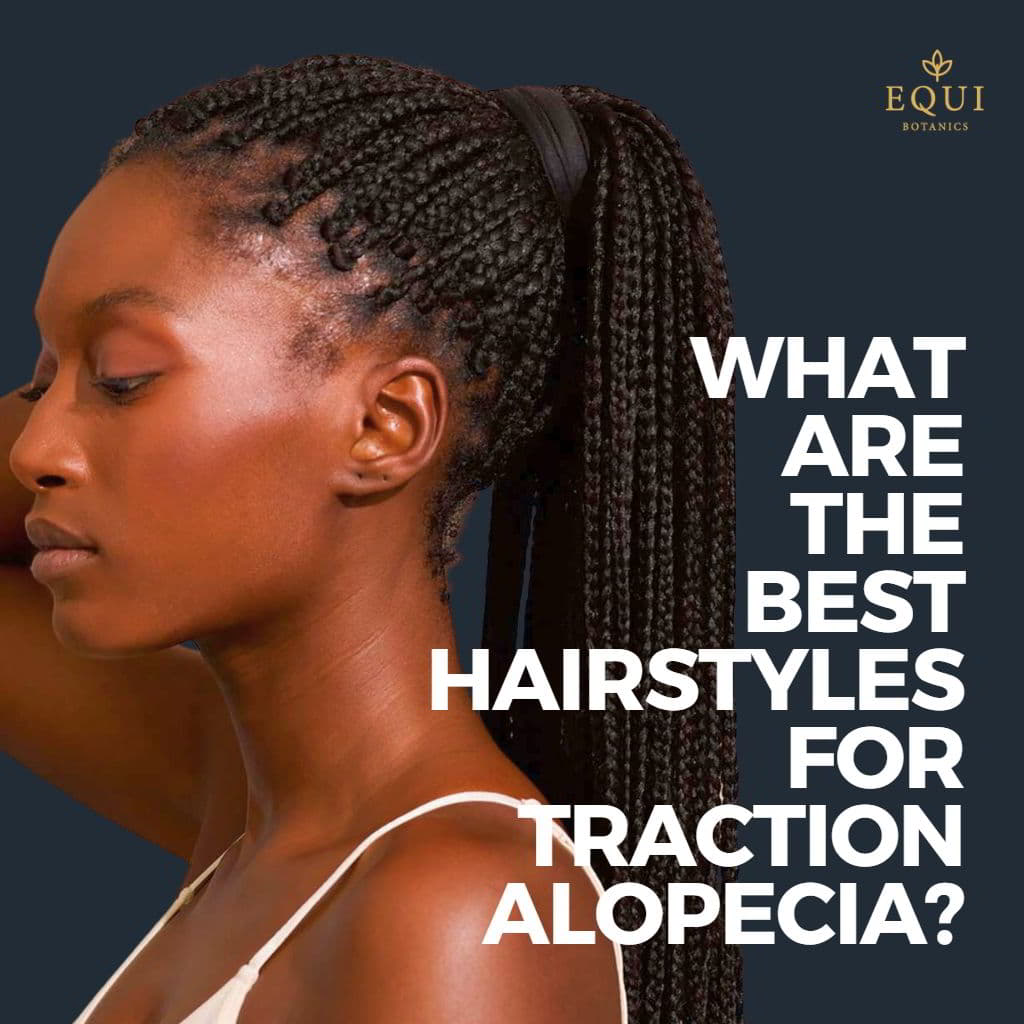
Suffering with traction alopecia can be tough, as not only is it stressful when dealing with hair loss, but finding suitable hairstyles can also be a struggle. The good news is hair loss doesn’t mean you can’t have great hair. We’re here to show you some on-trend hairstyles for traction alopecia looks that won’t damage your locks. So, keep reading!
Key Summary
- Traction alopecia is caused by tension, often through the use of tight hairstyles.
- Wearing loose styles, keeping hair natural or changing the cut are all ways to avoid hairstyles that cause tension to the hair and scalp.
- Switch to naturally-derived hair care and try daily scalp massages to support hair growth.
What is Traction Alopecia?

Traction alopecia is hair loss that’s caused by repeated and prolonged tension being applied to the hair. It’s often seen as a result of hairstyles, such as braids or ponytails, that pull on the hair tightly, causing damage to the follicles and resulting in hair loss.
Traction alopecia can affect anyone who styles their hair in ways that cause tension, but it is most commonly seen in those who wear braids, weaves or extensions. Although these are the most common causes, it can also occur in anyone who frequently wears their locks in tight hairstyles.
The condition typically presents as hair loss along the hairline, around the ears, and at the nape of the neck and you may even see inflamed scalp bumps after braids. Over time, the hair loss can become permanent, and the affected areas may become smooth and shiny, which is why it’s important to take action to prevent further damage at the first signs of traction alopecia.
Signs of Permanent Traction Alopecia
- Noticeable thinning or bald patches
- A shiny scalp or visible scarring
- No new hair growth
- The condition has been present for an extended period of time
- Affected areas may feel tender or sore
- No improvement in hair growth
6 Best Hairstyles for Traction Alopecia

If you are looking for hairstyles to prevent traction alopecia, then look no further. Here’s our top 6:
1. Loose Braids
Braids are a popular hairstyle for women, but they can cause traction alopecia if they are too tight. Loose braids can be a good alternative as they do not pull on the hair roots excessively.
2. Buns
Low and loose buns are a great option for women with traction alopecia as they create less tension on the hair roots whilst still looking stylish. It’s important to avoid using tight hair elastics or pins when creating a bun, as they can pull on the hair roots.
3. Short Haircuts
Short haircuts for women with alopecia can be a good option as they do not put tension on the hair roots. Having a good haircut can encourage regrowth and support scalp health. To further support your thinning hair, switch to nourishing, naturally-formulated hair care products that will work to get your hair in tip top condition!
4. Bangs
Having bangs cut in is a fun (yet stylish) way to cover up areas where your hair may be thinning along the hairline. This on-trend style is also a useful tool in how to grow your edges back and protect delicate regrowth underneath.
5. Style with Clips
Using clips is a great traction alopecia hairstyle that will minimise hairline tension. Place clips at the side of the head to draw hair away from the face, or create a half-up, half-down style to create volume whilst reading hairline pressure.
6. Natural Hair
Of course, one of the best ways to help your hair recover from traction alopecia and reduce tension on your locks is to simply go natural. Try the wash and go method; shampoo, then use a leave-in conditioner such as the Marula Leave-In Conditioner, and let your hair air dry.
This method is super low-maintenance, causes minimal stress to the hair, and can help prevent further damage.
Ways to Support Traction Alopecia Hair Health
Hairstyles are just one way of supporting your hair through traction alopecia. Some other traction alopecia treatments to encourage quick regrowth and prevent further hair loss include:
Natural Hair Products
Switching to naturally-derived formulations will help to keep your locks healthy and in better condition as well as supporting scalp health, which is essential for regrowth. We love the Afro Hair Care Regrowth Set which contains all you need to kickstart your growth journey.
Natural ingredients such as black seed oil, rosemary oil and apple cider vinegar are all known to help keep hair in good condition and stimulate hair growth.
Afro Hair Care Growth Set
We've jam-packed this Growth Set with luxurious ingredients to give you a kickstart on your hair growth journey. We've selected our best-selling and hair replenishing treatments as part of the set. And because we really want you to have a great time, we're giving this set away for less than getting each product individually.
Avoid Tight Hairstyles
As already mentioned, tight hairstyles as well as using weaves and extensions, can all contribute to traction alopecia. If you’re suffering from hair loss and think it could be as a result of your hair styles, then opt for gentle styles and avoid things such as locs or hair weaves with alopecia.
Massage Your Scalp
A daily five-minute scalp massage can help to stimulate the hair follicles improving circulation and encouraging regrowth. Use your fingers to gently massage your scalp in circular motions for a few minutes each day. On hair wash day, try to perform a longer massage and use a product such as the Black Seed Hair Oil Elixir which is known to support hair growth.
Black Seed Hair Oil Elixir
This Black Seed Oil For Hair is enriched with Fenugreek, Brahmi and Bhringaraj ayurvedic oils, our first hair serum is your best bet to reaching your hair goals. Stop split ends, check. Stop itchy scalp, check. Help accelerate growth, check check check. We've jam-packed this little bottle with luxurious ingredients from the Caribbean, India and the Amazonian rainforest to give you longer, thicker, and stronger hair in less time.
Use a Wide-Tooth Comb
When combing your hair, use a wide-tooth comb to avoid pulling and tugging on your hair. This is also better to use when hair is wet as brushing during or after a hair wash can cause further damage to the locks as they are more delicate when wet.
Protect Your Hair at Night
Sleeping with a silk or satin pillowcase can help reduce friction on your hair, which can prevent breakage and damage.
Avoid Harsh Chemicals
Chemical treatments, like relaxers and perms, can weaken your hair and cause breakage so we would recommend avoiding these types of treatments where possible.
Eat a Balanced Diet
A balanced diet rich in vitamins and minerals can help support healthy hair growth. Make sure you're getting enough protein, iron, and vitamin D, which are all important for hair health.
Frequently Asked Questions (FAQs)
How to Stimulate Hair Growth from Traction Alopecia?
Stimulating hair growth from Traction Alopecia can be a slow and challenging process, but it’s possible to stimulate regrowth by improving circulation to the scalp through daily scalp massage, use of stimulating oils, and eating nutrient-rich foods. Hair regrowth requires patience and consistency so don’t expect to see results overnight!
What is Late-Stage Traction Alopecia?
Late-stage Traction Alopecia is the most severe form of the condition, in which permanent hair loss has occurred. In this stage, the hair follicles have been damaged to the point that they are unable to produce new hair growth. Late-stage traction alopecia is often characterised by bald patches, thinning hair, and visible scarring on the scalp.
Can Hair Recover from Traction Alopecia?
Whilst you can reverse traction alopecia in some cases, it will depend on the severity of the condition and the extent of damage to the follicles. If you tackle traction alopecia early enough, the hair follicles may be able to recover with treatment but in the case of advanced traction alopecia, growth may not be possible.
Summary
Traction alopecia can be a frustrating and difficult condition to deal with, but there are ways to prevent further damage and encourage regrowth. Using gentle hairstyles that reduce the level of tension placed on the follicles is one important way to avoid further damage, but using stimulating hair products and taking other hair health steps will help. With the right care and attention, you can restore your hair to its natural beauty.


